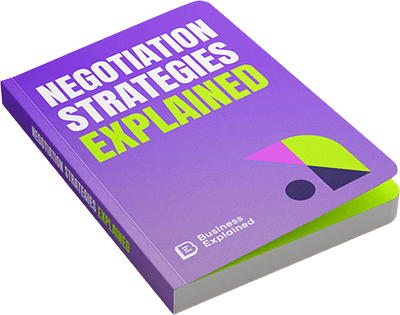Table of Contents
Negotiation is a critical skill in business, where the goal is often to reach an agreement that benefits all parties involved. The win-win negotiation strategy is a popular approach that focuses on finding mutually beneficial solutions, ensuring that all parties are satisfied. This blog post delves into various win-win negotiation techniques, their benefits, and real-world examples to help you master this essential skill.
What is a win-win strategy in negotiation?
Win-win negotiation, also known as integrative or interest-based bargaining, is a method in which all parties involved aim to find a solution that satisfies everyone’s interests. Unlike traditional adversarial negotiation, which often results in a zero-sum game, the win-win approach focuses on collaboration and mutual benefit. This strategy is based on the principle that when negotiators work together to understand each other’s needs and goals, they can create agreements that provide value to all sides.
A well-known example of win-win negotiation is the collaboration between Apple and Samsung. Despite being fierce competitors in the smartphone market, the two companies have negotiated several agreements where Samsung supplies critical components to Apple, benefiting both parties economically and strategically. This demonstrates how win-win strategies can lead to prosperous partnerships, even among rivals.
Win-win negotiation techniques
To achieve a win-win outcome, negotiators must employ specific techniques that foster collaboration and mutual understanding. Here are some essential techniques to consider:Understanding interests, not positions
One fundamental technique in win-win negotiation is focusing on interests rather than positions. Positions are a party’s specific demands or stances, while interests are the underlying reasons and motivations behind those positions. By understanding interests, negotiators can find common ground and explore creative solutions.
For instance, in a salary negotiation, an employee’s position might be a demand for a higher salary. However, their underlying interest could be financial security or recognition for their contributions. By understanding these interests, employers might offer alternative benefits such as flexible working hours, additional vacation days, or professional development opportunities, thereby satisfying the employee’s needs without solely focusing on salary.
Building trust and open communication
Trust and open communication are critical soft skills for successful win-win negotiations. Trust is necessary for parties to retain information, leading to misunderstandings and missed opportunities for collaboration.
Establishing a foundation of trust allows negotiators to share their true interests and work together towards a mutually beneficial solution. When parties are honest about their intentions and consistent in their actions, they create a conducive environment for open dialogue and cooperative problem-solving.
Tips for open communication:
- Ask open-ended questions: These encourage detailed responses that reveal underlying interests.
- Active listening: Show that you are engaged and interested in the other party’s perspective. This can be achieved through nodding, summarizing their points, and asking follow-up questions.
- Clarify assumptions: Ensure that all parties are on the same page and that any misunderstandings are promptly addressed.
Creating multiple options
Generating multiple options for mutual gain is another effective technique in win-win negotiation. Instead of fixating on a single solution, negotiators should brainstorm various possibilities to address all parties’ interests. This creative problem-solving approach increases the chances of finding a solution everyone can agree on.
In practice, this might involve developing different contract terms, exploring joint ventures, or finding ways to combine resources for a common goal. By considering various options, negotiators can identify innovative solutions that might not initially appear.
Mutual gain solutions
Aim for solutions that provide mutual gains rather than compromises. Compromises often mean that each party gives up something important, leading to less satisfaction. Mutual gain solutions, on the other hand, maximize the benefits for all involved.
Look for ways to increase the resources or benefits available so that each party gets more of what they want. Identify areas where one party values something more than the other and negotiate trade-offs accordingly.
4 win-win strategy examples
Understanding win-win strategies through real-world examples can provide valuable insights into their practical application. Here are a few notable examples:
#1 The Netflix and Marvel collaboration
When Netflix decided to expand its original content offerings, it entered into a win-win negotiation with Marvel to create several exclusive TV series based on Marvel’s characters. This collaboration allowed Netflix to attract new subscribers with popular content, while Marvel benefited from increased exposure and additional revenue streams. Both companies leveraged their strengths to achieve a mutually beneficial outcome.
#2 Toyota and GM’s NUMMI joint venture
In the early 1980s, Toyota and General Motors (GM) formed a joint venture called New United Motor Manufacturing, Inc. (NUMMI) to produce vehicles in California. Toyota gained valuable insights into the American market and labor practices, while GM benefited from Toyota’s efficient manufacturing techniques. This win-win strategy enabled both companies to improve their operations and competitiveness in the global market.
#3 The Pepsi and Starbucks partnership
In 1994, PepsiCo and Starbucks partnered to create and distribute ready-to-drink coffee beverages. This collaboration allowed Starbucks to enter the bottled coffee market with the expertise and distribution network of PepsiCo, significantly expanding its market reach.
On the other hand, PepsiCo benefited from Starbucks’ strong brand recognition and product innovation in the coffee sector. This mutually beneficial strategy enabled both companies to leverage each other’s strengths, leading to increased market share and profitability.
According to Boston magazine, the partnership resulted in the successful launch of the Frappuccino line, which generated over $52 million in annual sales by 1996. This demonstrates the significant mutual benefits derived from this win-win negotiation strategy.
#4 Microsoft and Nokia alliance
In 2011, Microsoft and Nokia entered into a strategic partnership, with Nokia using Microsoft’s Windows Phone operating system in its smartphones. This alliance was crucial for Microsoft to gain a stronger foothold in the mobile market. At the same time, Nokia benefited from using a robust operating system that differentiated its products in a competitive market dominated by iOS and Android.
The partnership combined Microsoft’s software expertise and Nokia’s hardware capabilities. Although Nokia eventually sold its mobile phone business to Microsoft, the initial collaboration allowed both companies to explore new market opportunities and improve their competitive positions. The deal highlighted how win-win negotiation can drive innovation and strategic growth, even in challenging markets.
Benefits of win-win negotiation

While the win-win negotiation strategy offers numerous benefits, it is essential to recognize that it may not be suitable for every situation. Here are some advantages of win-win negotiation:
- Improved relationships: Win-win negotiation fosters collaboration and trust, leading to more robust, positive relationships between parties. This is particularly beneficial for long-term business partnerships.
- Increased satisfaction: When parties feel that their interests have been considered and addressed, they are more likely to be satisfied with the outcome and committed to the agreement.
- Better outcomes: By focusing on mutual gains, win-win negotiations often result in more innovative and effective solutions that benefit all parties involved.
- Enhanced reputation: Businesses known for fair and balanced negotiation practices build a positive reputation, attracting more clients and partners who value integrity and cooperation.
- Sustainable agreements: Agreements reached through win-win negotiation are typically more sustainable, as they are designed to meet the core needs of all parties, ensuring long-term viability.
- Enhanced communication: This approach promotes open and honest communication. By sharing information and discussing interests openly, parties can better understand each other’s perspectives. This transparency helps to uncover underlying issues and facilitates finding common ground.
- Greater flexibility: Win-win negotiation allows for more flexibility. Instead of rigidly sticking to initial demands, parties can adapt and adjust their positions to find the best possible solution. This flexibility often leads to more effective and efficient agreements.
Win-win approach to negotiation
Implementing a win-win approach in negotiation involves several key steps that negotiators should follow to ensure success. These steps include preparation, understanding interests, building trust, creating options, and reaching a consensus.
Preparation for win-win negotiation
Effective preparation is crucial for a successful win-win negotiation. This involves researching the other party’s interests, goals, and constraints and clearly defining your own objectives. Gathering relevant information and anticipating potential challenges allows you to enter the negotiation with a well-informed strategy.
Negotiators who invest time in thorough preparation are more likely to achieve favorable outcomes. This preparation also includes developing a range of possible solutions and identifying areas where compromises can be made.
Understanding interests
As previously discussed, understanding the underlying interests of all parties is a fundamental aspect of win-win negotiation. This requires active listening and empathy to understand what is truly important to each party. Negotiators can uncover common ground and explore collaborative solutions. By prioritizing interests over positions
Building trust
Trust is the cornerstone of any successful negotiation. To build trust, negotiators should be honest, transparent, and reliable. This involves openly sharing information, being consistent in your actions, and demonstrating a genuine commitment to finding a mutually beneficial solution.
Creating options
Creating multiple options for mutual gain is a critical step in the win-win negotiation process. This involves brainstorming and exploring various possibilities that can address the interests of all parties. By generating a range of options, negotiators increase the likelihood of finding a solution that satisfies everyone involved.
Reaching consensus
Once multiple options have been generated, negotiators must work together to evaluate and refine these options, ultimately reaching a consensus. This requires effective communication, compromise, and a willingness to find common ground. By focusing on mutual benefits, negotiators can achieve an agreement that is acceptable to all parties.
H2: The win-win model of negotiation in business
The win-win model of negotiation is widely applicable in various business contexts, from contract negotiations to conflict resolution and strategic partnerships. Here are some specific applications of this model in business:
Contract negotiations
In contract negotiations, the win-win approach can help parties develop agreements that meet their respective needs while fostering positive relationships. For example, a supplier and a buyer might negotiate terms that ensure reliable delivery and competitive pricing, benefiting both parties and encouraging future collaboration.
Conflict resolution
Win-win negotiation is also effective in resolving conflicts within organizations. By focusing on underlying interests and exploring creative solutions, parties can address the root causes of the conflict and find resolutions that satisfy everyone involved. This approach helps to maintain a positive work environment and enhances team cohesion.
Strategic partnerships
When forming strategic partnerships, the win-win model can help businesses identify and leverage each other’s strengths to achieve common goals. For instance, two companies might collaborate on a joint marketing campaign, combining their resources and expertise to reach a wider audience and increase sales. To learn more about marketing strategies check out our marketing eBooks.
Challenges of implementing win-win strategies
While the win-win negotiation strategy offers numerous benefits, it is not without its challenges. Understanding these obstacles can help negotiators better prepare for and navigate the negotiation process. Here are some common challenges:
- Unequal power dynamics: One of the significant challenges in win-win negotiations is dealing with unequal power dynamics. When one party holds significantly more power or influence, it can be challenging to ensure a mutually beneficial outcome. The stronger party might dominate the negotiation, leading to imbalances that undermine the collaborative spirit of a win-win approach.
- Misaligned goals and interests: Achieving a win-win outcome requires that the parties’ goals and interests align to some extent. However, in some cases, the interests of the parties involved might be fundamentally opposed or incompatible. This misalignment can make it difficult to find solutions that satisfy all parties and requires creative problem-solving to bridge the gap.
- Resistance to collaboration: Not all parties may be open to a collaborative approach. Some negotiators may prefer competitive or adversarial tactics, seeing negotiation as a zero-sum game. This resistance can hinder the establishment of trust and open communication, essential components of win-win negotiation.
- Time constraints: Win-win negotiations often require more time and effort than traditional adversarial approaches. The process of understanding interests, building trust, and generating multiple options can be time-consuming. In high-pressure situations where quick decisions are needed, parties might find it challenging to invest the necessary time to achieve a win-win outcome.
- Cultural differences: Cultural differences can impact negotiation styles and expectations. In some cultures, direct communication and assertiveness are valued, while in others, indirect communication and harmony are prioritized. These differences can create misunderstandings and complicate building trust and finding mutually beneficial solutions.
- Overcoming past conflicts: Past conflicts or negative experiences between parties can create barriers to win-win negotiations. Historical grievances, mistrust, and lingering resentments can make establishing the collaborative environment necessary for a win-win outcome difficult. Addressing and overcoming these past issues requires patience, empathy, and a commitment to rebuilding trust.
Despite these challenges, the benefits of win-win negotiation make it a valuable strategy for fostering collaboration, innovation, and long-term success. By recognizing and addressing these obstacles, negotiators can enhance their ability to achieve mutually beneficial outcomes.
Win-win negotiation is a powerful strategy that prioritizes collaboration and mutual benefit, making it a valuable approach in various business contexts. Negotiators can attain outcomes that satisfy all parties involved by understanding interests, building trust, creating multiple options, and focusing on mutually beneficial solutions. By embracing these techniques and overcoming obstacles, negotiators can foster a culture of cooperation and long-term success in their professional interactions.


 Risk-free Purchase: Full refund within 14 days
Risk-free Purchase: Full refund within 14 days